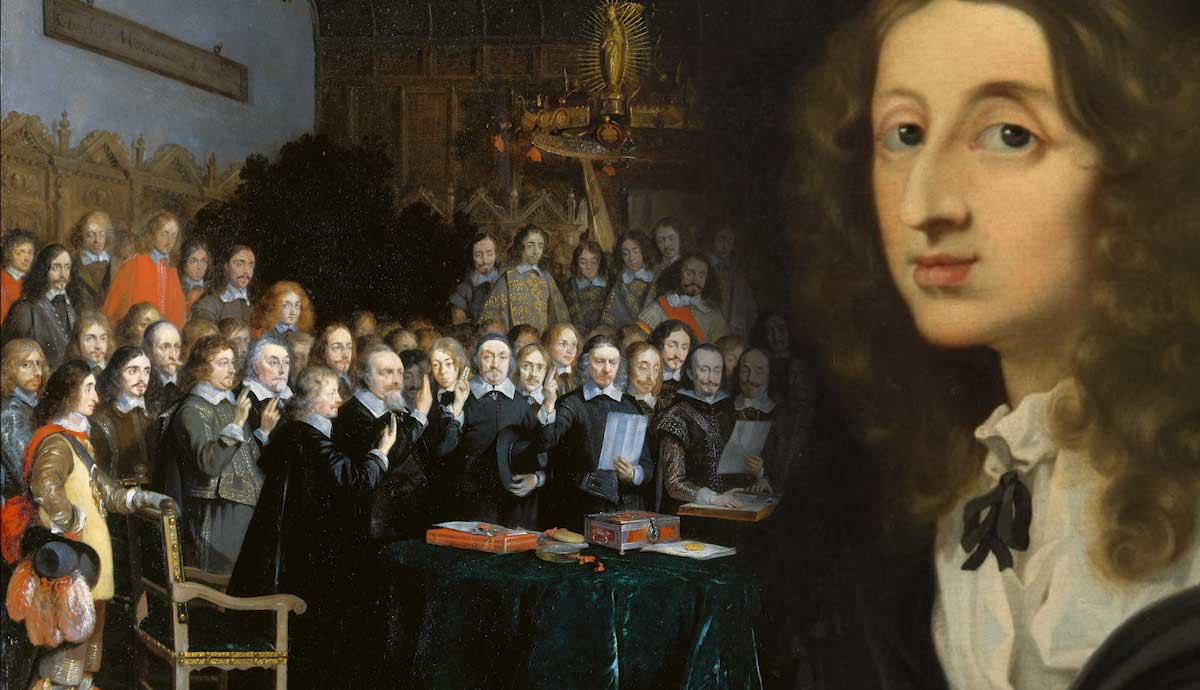
In an essay written in 1976, Laurel Thatcher Ulrich wrote, “well-behaved women seldom make history.” It has become a popular slogan, frequently seen printed on t-shirts and written on signs during women’s marches and in feminist spaces. The book of the same name Ulrich wrote in 2007 has made it even more popular. This slogan, too, applies very well to one Scandinavian Queen whose life was full of twists and turns.
Christina (also spelled Kristina), Queen of Sweden, made life-changing decisions that rocked the Europe of her time. War, peace, art, literature, philosophy, and political intrigue followed her every step as she navigated and rejected the etiquette of 17th-century Europe. She achieved her own freedom of thought at the back end of the Renaissance and during the Age of Enlightenment’s early stages. This woman made history by behaving against the norm.
Christina of Sweden: The Beginnings of a Child-Queen

Born on December 8th, 1626 in Stockholm, Christina Augusta Wasa of Sweden, who later changed her name to Christina Alexandra, was the daughter of King Gustavus II Adolphus and Maria Eleonora of Brandenburg. On the day of her birth and for at least a few minutes, the women who stayed by her mother Maria Eleonora’s side during labor thought Christina was a boy. It soon turned out that she was a girl. This came as a surprise, as her father, the King, wanted a boy, but Gustavus II Adolphus still celebrated Christina’s birth as if she were a male successor. In the 17th century, Sweden’s laws allowed an unmarried daughter to take the throne, and thus Christina became the King’s heir.
As a child, Christina spent her days with her father at Tre Kronor Castle, where she was born. She possibly followed him along as “he directed the copper mines, saw to the ships, and reviewed the troops.” King Gustavus II Adolphus educated his daughter in the ways of a ruler at a young age, as his father had done for him before. When the King left Stockholm every year, Russia, Denmark, or Poland were his ports of call. King Gustavus II Adolphus left home for the front lines, where he fought wars during the summers.
A Young Queen’s Coronation & Regency

After King Gustavus II Adolphus had many close calls with cannons and bullets, terrible news came to Stockholm. The King had died on the battlefield. Following her father’s death, Christina became queen-elect at the young age of six years old. She was alternatively in the care of her mother, with whom she did not have a warm relationship, and with her Aunt Catherine, with whom she went along much better. The High Council of nobles, with chancellor Axel Oxenstierna at its head, took over the country until Christina came of age.
Instructed as a prince, Christina started her education to become Queen. She was well-versed in many topics such as politics, history, languages (including Greek, Hebrew, and Arabic), mathematics, fencing, shooting, and horse-riding. Intellectually gifted, she loved to study anything and everything. So bright was her mind that council members admitted her to meetings as early as fourteen years old. When she came of age, Christina of Sweden was officially crowned Queen in 1644, at the young age of eighteen years old.
Christina of Sweden’s Fight for Peace in Europe

Meanwhile, the Thirty Years’ War raged in Europe. From 1618 to 1648, it caused “a death toll of approximately 8 million” Europeans following the Protestant Reformation and the religious conflicts that opposed Catholics and Protestants. The start of Christina of Sweden’s reign as Queen was tumultuous as she tried to keep external European conflicts and internal class rivalries at bay. Her country suffered from financial issues, too, since she lived a rather lavish lifestyle and became so unpopular that public unrest was brewing.
In the matters of foreign affairs, Queen Christina was an instigator of peace. She butted heads with Axel Oxenstierna about the war raging in Europe, as she wanted it stopped at once. He did not. Eventually, Axel Oxenstierna agreed to sign peace with Denmark at her demand. Christina of Sweden had an important diplomatic role in the signing of the Peace of Westphalia in 1648. This treaty ended the Thirty Years’ War. Following the Peace of Westphalia, Europe was changed forever: Spain lost its control over the Netherlands, France dominated the political landscape, and Sweden became chief of the Baltic Sea.
Queen Christina, Patron of the Arts

Apart from her desire for peace, Christina of Sweden earned herself a reputation for her love of the arts. She was passionate about books, paintings, manuscripts, astronomy, and all sciences. René Descartes himself taught her philosophy at court. Queen Christina founded Sweden’s first newspaper, the Post-och Inrikes Tidningar, too. It is still active to this day and went completely digital in 2007.
During Queen Christina’s reign, artists, musicians, theater actors, and opera singers flocked to Sweden’s capital. She invited Antoine de Beaulieu and his ballet troupe to her court, as well as “an Italian opera troupe in 1652 and a Dutch theatre troupe in 1653.” An avid music listener, she also welcomed a French orchestra to visit her court.
At the time, Stockholm earned its flattering title as the “Athens of the North.” Queen Christina herself soon became known as the “Minerva of the North” in courts all around Europe, where she was compared to the Roman goddess of the arts, wisdom, and war.
A Controversial Queen… Who Renounced Her Throne

The members of Christina of Sweden’s council were concerned, though, with her frivolousness. Her love of luxury and admiration for the finer things in life knew no bounds. She would only become financially secure in 1681, after years of living an unconventional life.
Breaking with tradition, as her father before her had been Lutheran, Queen Christina secretly converted to Catholicism during her reign. She was also possibly in love with another woman, Ebba Sparre, her protégée who was the same age as her, and she never wanted to marry or bear heirs. Therefore, her cousin Charles X Gustav, upon her request, became her successor. He was elected King in 1654 after she abdicated the throne.
Queen Christina left Ebba Sparre behind since she had married in the meantime, though she missed her dearly, as Queen Christina wrote in letters. Her next stop was Rome, where Pope Alexander VII greeted her himself. She was beloved there, as she was an intellectual with good manners, and found a deep friendship with Cardinal Decio Azzolino. She started a salon where she was, once more, patron of the arts. Respected as an intellectual in the Eternal City, her seemingly infinite thirst for knowledge delighted her contemporaries.
Christina of Sweden Abroad: Scandals in Rome & Paris

In Rome, Christina of Sweden stayed first in the Palazzo Farnese, then in the Palazzo Corsini, at the time known as the Palazzo Riario. This latter palace still contains masterpieces today, like The Triumph of Divine Providence by Pietro da Cortona, a portrait of Henry VIII by Hans Holbein, and Saint John the Baptist by Caravaggio. She was also a patron of the sculptor Bernini. Christina of Sweden, too, founded the Accademia dell’Arcadia, an academy of philosophy and literature that still stands today in Rome.
Even after she had abdicated her throne, Christina of Sweden was still known for her political cunningness. While on a trip to Paris in 1656, she schemed with Cardinal Mazarin, chief minister under Louis XIV, to become Queen of Naples, at the time under Spanish rule. Delays thwarted their plan and the Marquis of Monaldesco, a friend of Christina of Sweden, warned Naples of their intentions. Mazarin called off the scheme.
Queen Christina’s involvement in Naples was a blow to her reputation when it exploded into a political scandal. In a seemingly uncharacteristic fit of violence on Christina of Sweden’s part, she had the Marquis of Monaldesco assassinated. Following this bloodshed, France and Spain signed the Treaty of the Pyrenees in 1659, rending her efforts to become Queen of Naples null, and Pope Alexander VII didn’t welcome Christina back to Rome.
Queen Christina, Exiled from Rome… Then Welcomed Back to Rome

Following her expulsion by the Pope, Christina of Sweden continued to travel around Europe. She made two trips to Sweden in 1660 and 1667. In 1667, while on a stop in Hamburg, she tried to seize the Polish crown. This new political involvement was also a failure. Queen Christina created another political scandal, much like the one she left in her wake in Paris. Yet this time, she had the support of the Pope, now Clement IX, and was welcomed back to Rome.
Queen Christina stayed there until her death. Friends with four popes, Christina of Sweden also involved herself in the Vatican Church’s politics when she pushed for war against the Ottoman Empire.
Although her political cunningness created scandals in the European courts she visited throughout her life, Christina of Sweden is remembered for her patronage of the arts, her paintings from the Venetian school of arts, and her collection of many books and manuscripts. Her collection remains today in the Vatican library.
Christina of Sweden pushed for freedom of thought, opened the Tordinona, Rome’s first public opera house; created charities, and pushed for a more tolerant environment in the city. A defender of religious minorities, she advocated for the Jewish population of Rome and supported the Huguenots in a letter published in the Nouvelles de la République des Lettres.
Christina of Sweden: Death & Legacy

Christina of Sweden died in 1689 in Rome, Italy at the age of sixty-three. Her tomb is located in St Peter’s Basilica, where a monument in her memory made by Carlo Fontana stands to this day. Only four women, including her, are buried in St Peter’s Basilica. The other three are Charlotte of Lusignan, Queen of Cyprus, who lived between 1447 and 1487; Agnesina Colonna Caetani, a noblewoman who died in 1578; and Maria Clementina Sobieski, who was married to James Stuart, pretender to the English throne, and died in 1735.
In the end, who was Christina, Queen of Sweden? Born to a royal family that encouraged her education like a prince of her time, she was a Scandinavian queen, a patron of the arts, and a political conniver. She was all these things and more. A multi-faceted woman, she rejected marriage and her throne to travel Europe as she pleased, even as she tried to pull her own strings and left political scandals in her wake. Her decisions, too, shocked the courts of her time. Today, she is remembered as a powerful figure in Scandinavian history.
Her entire life, from her accession to the Swedish throne to her death in 1689, can earn her the title, as Laurel Thatcher Ulrich would put it, of a misbehaved woman who made history.










